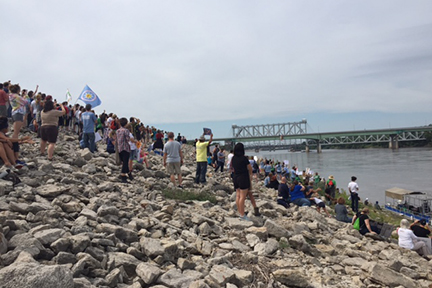Last winter my 5-year-old son, Zeke, and I stayed with some friends in Omaha. He could have thrown a rock in the Missouri River from the balcony of their condo. Last weekend, Zeke and I were standing on the banks of the same river in our hometown of Kansas City. His 8-year-old sister, Maeve, and 3-year-old sister, Blythe, listened as I asked him if he remembered that trip to Omaha. He said yes. When I told him the water churning past us was the same river we had looked out on in Omaha, he fell silent.
Zeke is rarely quiet. He had not interacted much with the Missouri. If he knew it at all, he knew it as something we drive over on our way to the airport a few times a year. But last weekend he was finally seeing the river for what it is: a living, moving connection to people he loves. In that moment, those people we visited last year seemed a lot closer.
Along with my wife and her parents, we were at the Missouri River Solidarity demonstration. We had come to the river with our homemade signs to show support for the American Indian community leaders who are making history at the Camp of the Sacred Stones.
This historic protest is taking place at the home of the Standing Rock Sioux Tribe but has also drawn numbers and strength from across Indian Country. My family is not Native. Our family business Travois raises investment capital to support housing and community development in Indian Country. This work didn’t give us any special right or reason to be there. But the many Native American friends we have gained over 21 years in business have educated us about the issues that have sparked the protests at Standing Rock.
These issues are rooted in the concept of tribal sovereignty. They comprise the legal requirement of tribal consultation, the manner in which tribes manage cultural assets and the friction that takes place at the intersection of tribal, state and federal law. They are all thrown into stark relief against the backdrop of global climate change.
Because many of my friends in Kansas City haven’t been blessed with the friendships and experiences that have caused my education in these matters, I found myself struggling to explain why my family would be at this kind of demonstration. The look on Zeke’s face as he squinted up-river in search of our Omaha friends is the best explanation I can think of. If you live anywhere in the great watershed that feeds the Missouri River, your interests are aligned with the protestors.
This pipeline is designed to pump 500,000 gallons of crude oil per day under the Missouri River — the largest source of drinking water for America’s heartland. Pipelines leak. No community along the Missouri can afford the human and financial cost of a leak in the wrong place.
I believe the protestors at the Camp of the Sacred Stones will succeed. I believe the construction of this pipeline will either stop or change significantly to address tribal concerns. I believe our country will overhaul its energy infrastructure. I believe the historic climate deal negotiated in Paris last year will be implemented in time to limit global temperature increases to 2 degrees. I even believe our elected officials will, through a mix of their principles and our pressure, do their share of the work in the effort to save the world.
I believe these things for the same reason Zeke can believe that, even though he can’t see them, that our friends are somewhere up around that bend in the river. And we are counting on each other.



Good read and thank you for standing beside our people because we only have one Mother Earth!
Thank you for reading, Joe.
Hi, Joe – Thanks for reading!
We were happy to see the Wyoming Public Radio stories bringing attention to the housing crisis on the Wind River Reservation. Congratulations on nearing completion of Tigee Village and making progress on the ICDBG project. We’re proud to have ESHA as a client.